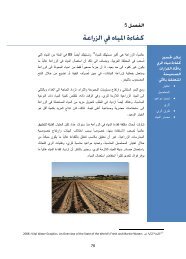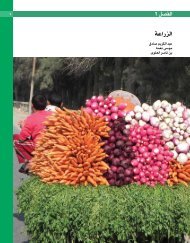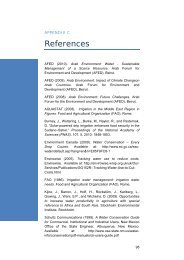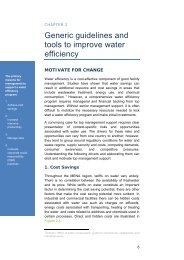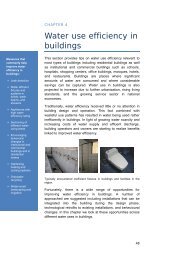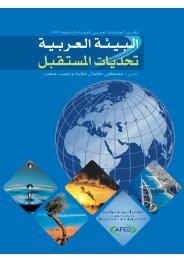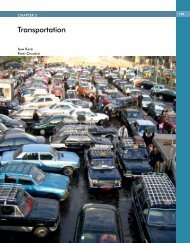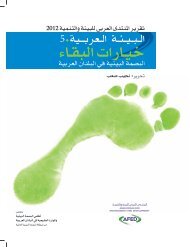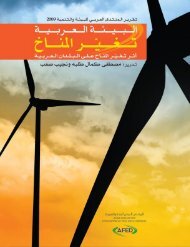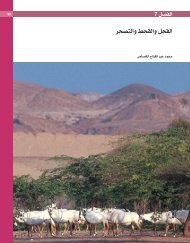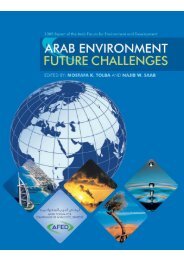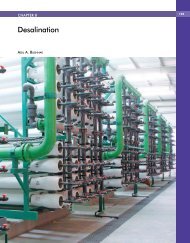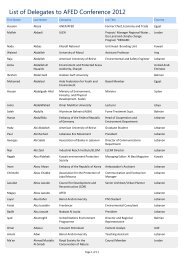Impact of Climate Change on Arab Countries - (IPCC) - Working ...
Impact of Climate Change on Arab Countries - (IPCC) - Working ...
Impact of Climate Change on Arab Countries - (IPCC) - Working ...
Create successful ePaper yourself
Turn your PDF publications into a flip-book with our unique Google optimized e-Paper software.
42<br />
CHAPTER 3<br />
A REMOTE SENSING STUDY OF IMPACTS OF GLOBAL WARMING ON THE ARAB REGION<br />
FIGURE 13<br />
RAPID URBAN GROWTH IN CAIRO BETWEEN 1984-2002 CAUSED SIGNIFICANT<br />
RISE IN SURFACE TEMPERATURE (SHOWN IN RED COLOR), REFERRED TO AS<br />
URBAN HEAT ISLAND (UHI) EFFECT<br />
(CRS-BU, E. Gh<strong>on</strong>eim - AFED 2009 Report)<br />
Urbanizati<strong>on</strong> can have significant effects <strong>on</strong><br />
local weather and climate (Landsberg, 1981),<br />
which in turn can c<strong>on</strong>tribute greatly to global<br />
warming. Urban expansi<strong>on</strong> usually arises at the<br />
expense <str<strong>on</strong>g>of</str<strong>on</strong>g> vegetati<strong>on</strong> cover when open space is<br />
c<strong>on</strong>verted to buildings, roads, and other infrastructure.<br />
Urban materials used to build these<br />
structures do not have the same thermal properties<br />
as vegetati<strong>on</strong> cover, and c<strong>on</strong>sequently, can<br />
largely influence the local urban climate. The<br />
urban geometry <str<strong>on</strong>g>of</str<strong>on</strong>g> a city can increase surface<br />
temperatures as well by obstructing air flow and<br />
preventing cooling by c<strong>on</strong>vecti<strong>on</strong>.<br />
Studies <strong>on</strong> surface temperature characteristics <str<strong>on</strong>g>of</str<strong>on</strong>g><br />
urban areas using satellite remote sensing data<br />
have been c<strong>on</strong>ducted primarily using the thermal-infrared<br />
band from Landsat Enhanced<br />
Thematic Mapper Plus (ETM+) data. As illustrated<br />
in Figure 13, Cairo shows a significant<br />
rise in surface temperature with a general trend<br />
<str<strong>on</strong>g>of</str<strong>on</strong>g> warmer urban areas versus cooler surrounding<br />
cultivated land.<br />
In the future, urban climate change will be <str<strong>on</strong>g>of</str<strong>on</strong>g><br />
importance to a larger and larger number <str<strong>on</strong>g>of</str<strong>on</strong>g> residents<br />
<str<strong>on</strong>g>of</str<strong>on</strong>g> the <strong>Arab</strong> world. With such a significant<br />
and rising fracti<strong>on</strong> <str<strong>on</strong>g>of</str<strong>on</strong>g> the <strong>Arab</strong> world’s populati<strong>on</strong><br />
c<strong>on</strong>centrated in urban areas, local climatic effects<br />
will be felt by a great number <str<strong>on</strong>g>of</str<strong>on</strong>g> people.<br />
VI. DUST STORMS IN THE<br />
ARAB DESERTS<br />
Aerosol polluti<strong>on</strong> caused by dust storms can<br />
modify cloud properties to reduce or prevent<br />
precipitati<strong>on</strong> in the polluted regi<strong>on</strong>. Aerosol<br />
c<strong>on</strong>taining black carb<strong>on</strong> can impact the climate<br />
and possibly reduce formati<strong>on</strong> <str<strong>on</strong>g>of</str<strong>on</strong>g> clouds. The<br />
decrease in precipitati<strong>on</strong> from clouds affected<br />
by desert dust can cause drier soil, which in turn<br />
raises more dust into the air, c<strong>on</strong>sequently providing<br />
a potential feedback loop to further<br />
decrease rainfall. Moreover, anthropogenic<br />
changes <str<strong>on</strong>g>of</str<strong>on</strong>g> land use exposing the topsoil can initiate<br />
such a desertificati<strong>on</strong> feedback process.<br />
(Rosenfeld et al., 2001)<br />
Urbanizati<strong>on</strong> not <strong>on</strong>ly increases the local temperature<br />
but also creates industrial districts that<br />
cause atmospheric polluti<strong>on</strong> and reduce local<br />
air quality. With the c<strong>on</strong>tinuous build-up <str<strong>on</strong>g>of</str<strong>on</strong>g> climate<br />
change emissi<strong>on</strong>s in the atmosphere from<br />
unregulated industrial emissi<strong>on</strong>s, many desert<br />
regi<strong>on</strong>s will get hotter and drier in a phenomen<strong>on</strong><br />
called the amplificati<strong>on</strong> effect; that is,<br />
already hot and dry places <strong>on</strong> Earth will become<br />
even more so. C<strong>on</strong>sequently, dust storms in the<br />
desert will become more frequent and intense.<br />
Research shows that dust storms are increasing



